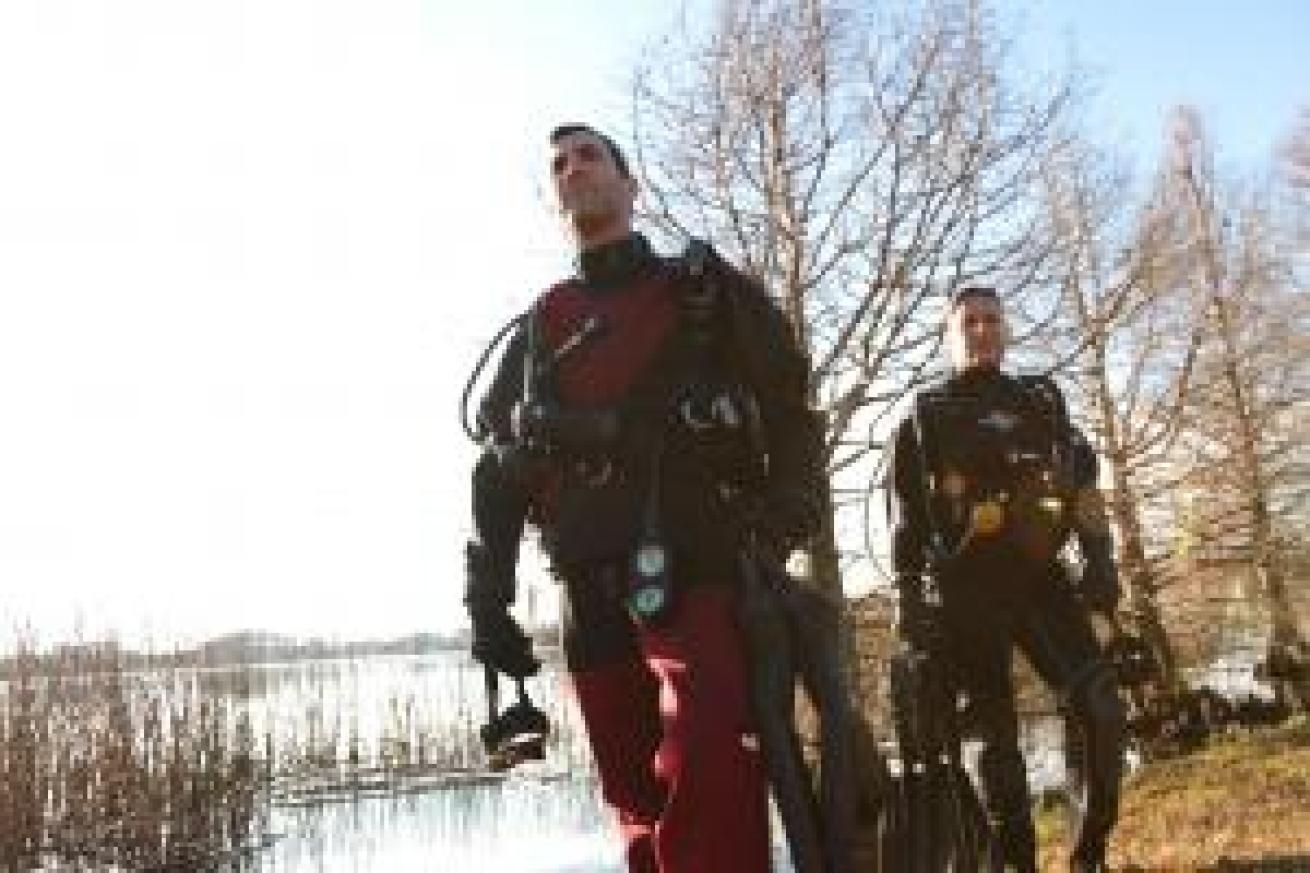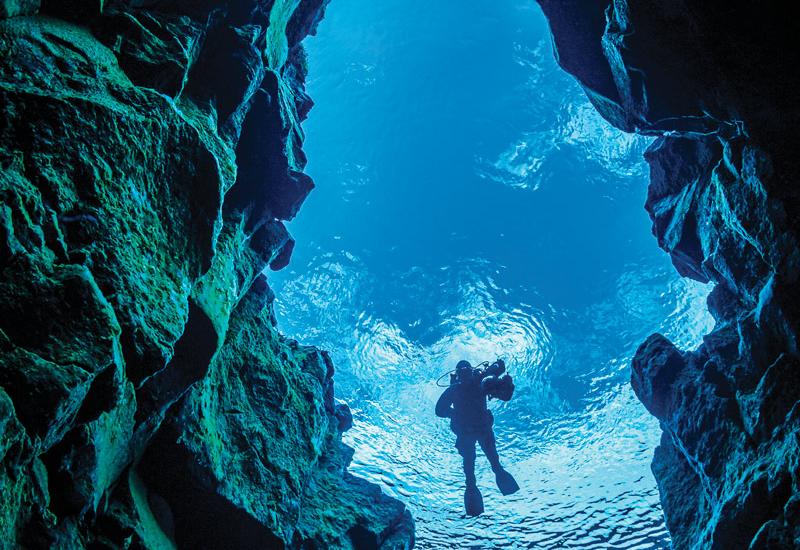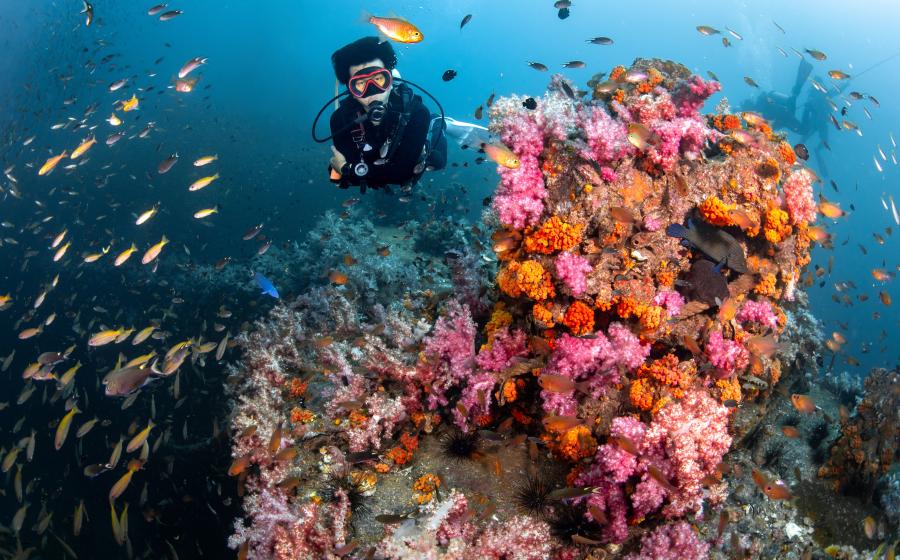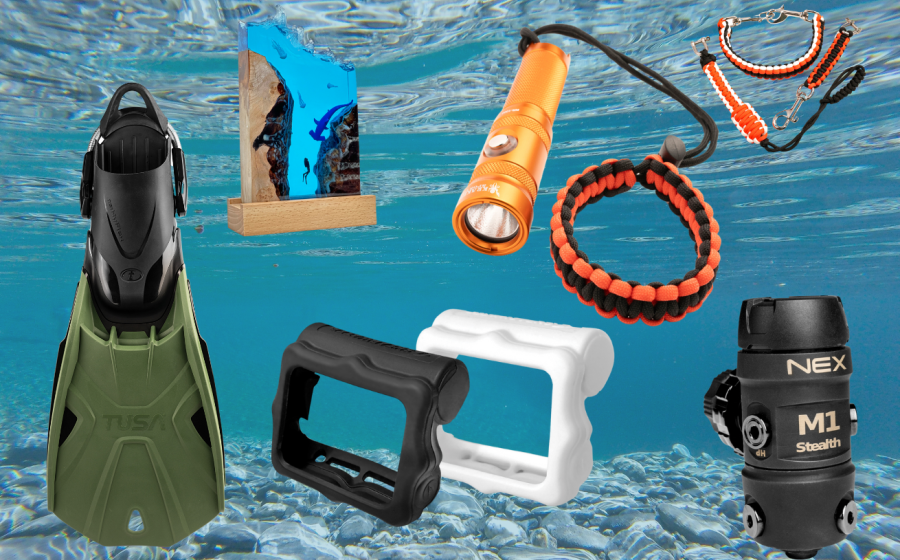What to Look For in a Drysuit

Jon Whittle
Cold-water divers looking for comfort, fit and insulation in a drysuit have more choices than ever. The purpose of an exposure suit is to maintain a thermal balance between your body and the ocean. Because it’s a lot easier to heat air than water, diving in a drysuit is a much more energy-efficient way to stay warm and comfortable while cruising the depths. Selecting the drysuit that best meets your needs is all about making choices. So where should you begin? Right here.
Neoprene or Fabric?
Neoprene drysuits are made of traditional neoprene foam rubber with watertight seams, seals and zippers. The ability to stretch means a neoprene suit can fit snugly and comfortably while still offering good range of motion. While neoprene is saddled with inherent buoyancy that has to be counter-balanced with ballast weight, it also provides its own thermal properties, so the undergarment doesn’t have to be as thick or heavy as those you would wear with a fabric suit.
Fabric drysuits, made mostly of bilaminate or trilaminate materials, are lightweight, have no inherent buoyancy and don’t compress at depth, plus they dry quickly and fold compactly for transport. They don’t tend to stretch much though, so they need to fit loosely (built-in features like telescoping torsos and expandable gussets help ameliorate this). Fabric suits are often referred to as “shell” suits because they don’t contribute to keeping you warm — their only job is to keep water out. Fabric-suit divers rely solely on undergarments for their thermal protection.
Once you’ve made the decision to go neoprene or fabric, you’re faced with additional choices.
**• Neoprene: Traditional or Compressed
**Traditional neoprene drysuits are made of 7mm or 8mm wetsuit foam rubber, which is comfortable and, because of its insulation, requires less in the way of undergarments. However, this neoprene is extremely buoyant, and it compresses at depth, which reduces its effectiveness at providing warmth.
Like its name implies, compressed neoprene is wetsuit rubber that’s been pre-compressed to 3mm or 4mm, making the rubber more dense and less buoyant but still able to provide some thermal protection. These suits are high-stretch, so they can fit snugly without sacrificing range of motion, thereby minimizing hydro-drag, and they don’t require much in the way of undergarments. (There’s also something called crushed neoprene, which is even thinner and denser and extremely durable.) These modern suits offer the flexibility of a wetsuit with the warmth of a drysuit. They are the exposure suits of choice among today’s neoprene drysuit divers.
**• Fabric: Light-Duty or Heavy-Duty
**With today’s shell suits you can choose from a range of durability levels, depending on how much and what kind of diving you do.
Hardcore divers who are constantly in the water hunting down among the rocks, exploring caves or working on scientific projects should probably look at suits constructed of heavy-duty materials with extra layers of abrasion protection in the high-wear areas. More casual divers who are not in the water quite as much and who tend to do mostly sightseeing might not need to be encased in such rugged armor. Light-duty suits weigh less and are quite comfortable. They aren’t designed to stand up to lots of abuse, but they don’t cost as much as the heavy-duty suits either.
**Rear Zip or Front Zip?
**The standard rear-entry drysuit has a zipper that runs horizontally along the shoulders. These are normally less expensive than front-zip designs. They also are easy to don and doff, but they require the help of a buddy to zip up.
Front-entry designs, with a zipper that runs either diagonally across the chest and hips or horizontally across the chest or the waist, are also referred to as “self-donning” suits. While this is technically true, in reality, not all divers can put on a self-donning suit without assistance. If you don’t have the range of motion in your arms and shoulders, fully zipping the suit or climbing out after a dive without assistance might not be doable. So if the self-donning feature is the reason you’re buying a suit, before laying down a pile of cash, make sure you can actually self-don it. (Note: a couple of drysuit makers have come up with rear zippers that can be self-zipped with a little practice, but, again, try before you buy.)
**Soft Socks or Attached Boots? **
Soft socks allow you to choose from a variety of drysuit overboots touting different lace-up designs and tread patterns to suit different diving styles. Soft socks also enable you to turn the suit completely inside-out for cleaning/drying/airing after a day of diving. Attached boots, on the other hand, are really convenient because they simplify the donning process and eliminate having to deal with extra gear. However, they range from flimsy latex to rugged vulcanized rubber offering lots of foot support and aggressive tread. Each has its own place, but the boot you choose must be able to handle the type of diving you do. Otherwise, you’ve created a weak link in your drysuit system where there doesn’t need to be one.
**Neoprene, Latex or Silicone Seals? **
As a general rule, you’ll find neoprene seals on neoprene drysuits and latex or silicone seals on shell suits. That said, it is possible to put neoprene seals on shell suits and latex seals on neoprene suits, so it all comes down to preference.
Some neoprene seals are smooth-skin-in, where the skin-in areas on the wrists and neck lay directly against your skin. Other seals are smooth-skin-out. With these you fold the neoprene under so the seal’s smooth skin is against your skin. This design is easier to get in and out of because you’re pushing your wrists and head through nylon rather than smooth-skin, and they create a very comfortable seal. Neoprene seals last a long time and they provide a modicum of thermal protection.
Latex seals come in either cone-shaped or bell-shaped styles. Cone-shaped seals allow for trimming to fine-tune fit; bell-shaped seals provide more surface sealing area. There’s an ongoing debate among drysuit makers over which provides a better seal, although both styles have proven track records for keeping water out. The thickness of latex varies; thinner latex is much easier to work with, but is more susceptible to tearing. Thicker latex is tougher, but is harder to work with and can be less comfortable.
Some drysuit divers are allergic to latex. That’s where silicone comes in. Similar in appearance to the latex variety, silicone drysuit seals offer more resistance to both ozone and UV rays, they are extremely pliable, and they are very easy to put on and take off. Some drysuit manufacturers offer their latex and silicone seals in replaceable systems that enable you to change torn seals on the spot without having to interrupt your dive day.
**Valve Positioning
**The vast majority of modern drysuits, both neoprene and shell, use a dual valve system: one inflate valve positioned on the chest for pumping air into the suit, and one exhaust valve, usually located on the upper left arm, for venting air out of the suit. While this just-below-the-shoulder exhaust valve position tends to be the highest spot on your body while in a heads-up diving attitude, it sometimes can be difficult to reach when fully geared up, and it can also be hard to see. For these reasons some drysuit makers will place the primary exhaust valve, or add a secondary exhaust valve, on the lower left arm, about midway between elbow and wrist. This can be a huge benefit when controlling a suit’s airflow because you can easily see it and reach it, and to bleed air you simply raise your arm. Some makers also offer ankle valves designed to bleed air in a heads-down position. All exhaust valves work either manually by pushing a button, or automatically by dialing the valve from a fully open to a fully closed position.
**Drysuit Extras
**These are the add-ons, the goodies, the icing on the proverbial cake. You probably don’t actually need any of this stuff, but you’re probably going to want all of it.
Some enticing examples: Suspenders — they not only rein in a drysuit while diving, but just as important, between dives, suspenders allow you to drop the top half of the suit without everything falling around your ankles. Then there are cargo pockets for stashing gear, tools or treasures, neoprene neck warmers on drysuits with latex neck seals to provide a little thermal protection where there is none, and, guys, don’t forget the crotch-level relief valve that lets you take care of business without having to take the suit completely off. These and myriad other accessories make the drysuit-diving experience just that much more enjoyable.
To see the latest drysuits and wetsuits on the market today, see our Gear Guide.
John Brumm is Sport Diver’s Gear Editor.










